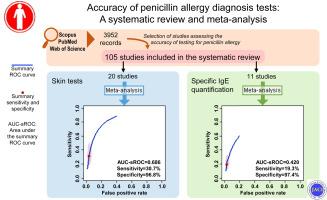Journal of Allergy and Clinical Immunology ( IF 11.4 ) Pub Date : 2020-05-21 , DOI: 10.1016/j.jaci.2020.04.058 Bernardo Sousa-Pinto 1 , Isabel Tarrio 2 , Kimberly G Blumenthal 3 , Luís Araújo 4 , Luís Filipe Azevedo 5 , Luís Delgado 4 , João Almeida Fonseca 5

|
Background
Having a penicillin allergy label associates with a higher risk for antibiotic resistance and increased health care use.
Objective
We sought to assess the accuracy of skin tests and specific IgE quantification in the diagnostic evaluation of patients reporting a penicillin/β-lactam allergy.
Methods
We performed a systematic review and diagnostic accuracy meta-analysis, searching on MEDLINE, Scopus, and Web of Science. We included studies conducted in patients reporting a penicillin allergy and in whom skin tests and/or specific IgE quantification were performed and compared with drug challenge results. We quantitatively assessed the accuracy of diagnostic tests with bivariate random-effects meta-analyses. Meta-regression and subgroup analyses were performed to explore causes of heterogeneity. Studies’ quality was evaluated using QUADAS-2 criteria.
Results
We included 105 primary studies, assessing 31,761 participants. Twenty-seven studies were assessed by bivariate meta-analysis. Skin tests had a summary sensitivity of 30.7% (95% CI, 18.9%-45.9%) and a specificity of 96.8% (95% CI, 94.2%-98.3%), with a partial area under the summary receiver-operating characteristic curve of 0.686 (I2 = 38.2%). Similar results were observed for subanalyses restricted to patients reporting nonimmediate maculopapular exanthema or urticaria/angioedema. Specific IgE had a summary sensitivity of 19.3% (95% CI, 12.0%-29.4%) and a specificity of 97.4% (95% CI, 95.2%-98.6%), with a partial area under the summary receiver-operating characteristic curve of 0.420 (I2 = 8.5%). Projected predictive values mainly reflect the low frequency of true penicillin allergy.
Conclusions
Skin tests and specific IgE quantification appear to have low sensitivity and high specificity. Because current evidence is insufficient for assessing the role of these tests in stratifying patients for delabeling, we identified key requirements needed for future studies.
中文翻译:

青霉素过敏诊断测试的准确性:系统评价和荟萃分析。
背景
拥有青霉素过敏标签与抗生素耐药性和医疗保健使用增加的风险有关。
客观的
我们试图评估皮肤测试和特定 IgE 量化在对报告青霉素/β-内酰胺过敏的患者的诊断评估中的准确性。
方法
我们在 MEDLINE、Scopus 和 Web of Science 上进行了系统评价和诊断准确性荟萃分析。我们纳入了在报告青霉素过敏的患者中进行的研究,并在其中进行了皮肤测试和/或特定 IgE 量化,并与药物激发结果进行了比较。我们使用双变量随机效应荟萃分析定量评估了诊断测试的准确性。进行了荟萃回归和亚组分析以探索异质性的原因。使用 QUADAS-2 标准评估研究质量。
结果
我们纳入了 105 项主要研究,评估了 31,761 名参与者。通过双变量荟萃分析评估了 27 项研究。皮肤试验的总敏感性为 30.7%(95% CI,18.9%-45.9%),特异性为 96.8%(95% CI,94.2%-98.3%),在总结受试者操作特征曲线下有部分面积0.686 ( I 2 = 38.2%)。对于仅限于报告非即发性斑丘疹或荨麻疹/血管性水肿的患者的亚组分析,也观察到了类似的结果。特异性 IgE 的总体敏感性为 19.3%(95% CI,12.0%-29.4%),特异性为 97.4%(95% CI,95.2%-98.6%),在总结受试者操作特征曲线下有部分面积0.420 ( I 2 = 8.5%)。预计的预测值主要反映真实青霉素过敏的低频率。
结论
皮肤测试和特异性 IgE 定量似乎具有低敏感性和高特异性。由于目前的证据不足以评估这些测试在分层患者以去除标签中的作用,因此我们确定了未来研究所需的关键要求。











































 京公网安备 11010802027423号
京公网安备 11010802027423号